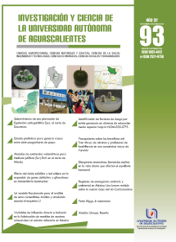A fractional model for the analysis of edible mushrooms: Analysis and simulation using the L1 scheme
DOI:
https://doi.org/10.33064/iycuaa2024934984Keywords:
logistic function, Caputo time-fractional derivative, L1 differences, asymptotical stability, order of convergence, fixed point theoremAbstract
In this research, a generalization of Verhulst’s equation is proposed, to establish a model of fungus growth, the Caputo time-fractional derivative is used to that end. The main property of the logistics function is an asymptotic equilibrium point, it is verified that this generalization also accomplishes this state. With the help of a fixed-point theorem, it is verified the existence of a solution for the numerical method, which utilizes L1 differences, also it is explicit, and convergent to the solution of the continuous system. Some simulations are presented in order to verify the properties previously proved, such as the order of convergence and graphical simulations.
Downloads
References
• Ali Shah, N., Ahmed, N., Elnaqeeb, T., & Rashidi, M. M. (2019). Magnetohydrodynamic free convection flows with thermal memory over a moving vertical plate in porous medium. Journal of Applied and Computational Mechanics, 5(1), 150-161.
• Brandibur, O., Garrappa, R., & Kaslik, E. (2021). Stability of systems of fractional-order differential equations with Caputo derivatives. Mathematics, 9(8), 914. DOI: https://doi.org/10.3390/math9080914
• Caputo, M., & Cametti, C. (2021). Diffusion through skin in the light of a fractional derivative approach: progress and challenges. Journal of Pharmacokinetics and Pharmacodynamics, 48(1), 3-19. DOI: https://doi.org/10.1007/s10928-020-09715-y
• Ding, Y., Wang, Z., & Ye, H. (2011). Optimal control of a fractional-order HIV-immune system with memory. IEEE Transactions on Control Systems Technology, 20(3), 763-769. DOI: https://doi.org/10.1109/TCST.2011.2153203
• Lin, Y., & Xu, C. (2007). Finite difference/spectral approximations for the time-fractional diffusion equation. Journal of computational physics, 225(2), 1533-1552. DOI: https://doi.org/10.1016/j.jcp.2007.02.001
• Macías-Díaz, J. E., Serna-Reyes, A. J., & Flores-Oropeza, L. A. (2024). A stable and convergent finite-difference model which conserves the positivity and the dissipativity of Gibbs’ free energy for a nonlinear combustion equation. Journal of Computational and Applied Mathematics, 437, 115492. DOI: https://doi.org/10.1016/j.cam.2023.115492
• Ortiz, J. M., & Hernández, L. R. (2013). The theorem existence and uniqueness of the solution of a fractional differential equation. Acta Universitaria, 23, 16-18. DOI: https://doi.org/10.15174/au.2013.593
• Ostwald, W. (1883). Studien zur chemischen Dynamik fuer Praktische Chemie, 136 (n.s. 27, 28), 1–39, 449–495. DOI: https://doi.org/10.1002/prac.18830280139
• Podlubny, I. (1998). Fractional differential equations: an introduction to fractional derivatives, fractional differential equations, to methods of their solution and some of their applications. Elsevier.
• Real, L. A. (1977). The Kinetics of Functional Response. The American Naturalist, 111(978), 289–300. DOI: https://doi.org/10.1086/283161
• Robertson, T. B. (1908). On the normal rate of growth of an individual, and its biochemical significance. Archiv für Entwicklungsmechanik der Organismen, 25(4), 581-614. DOI: https://doi.org/10.1007/BF02163864
• Sarikaya, A., & Ladisch, M. R. (1997). An unstructured mathematical model for growth of Pleurotus ostreatus on lignocellulosic material in solid-state fermentation systems. Applied biochemistry and biotechnology, 62, 71-85. DOI: https://doi.org/10.1007/BF02787985
• Swan, G. W. (1986). Cancer chemotherapy: Optimal control using the Verhulst-Pearl equation. Bulletin of mathematical biology, 48, 381-404. DOI: https://doi.org/10.1016/S0092-8240(86)90034-0
• Verhulst, P.F. (1838). Notice sur la loi que la population suit dans son accroissement. Correspondence Mathematique et Physique (Ghent), 10, 113-121.
• Zhuang, P., & Liu, F. (2006). Implicit difference approximation for the time fractional diffusion equation. Journal of Applied Mathematics and Computing, 22, 87-99. DOI: https://doi.org/10.1007/BF02832039
Downloads
Published
How to Cite
License
Copyright (c) 2024 Adán Jair Serna-Reyes, Jorge Eduardo Macias-Diaz, Pamela Romo-Rodríguez

This work is licensed under a Creative Commons Attribution-NonCommercial-ShareAlike 4.0 International License.
Las obras publicadas en versión electrónica de la revista están bajo la licencia Creative Commons Atribución-NoComercial-CompartirIgual 4.0 Internacional (CC BY-NC-SA 4.0)









